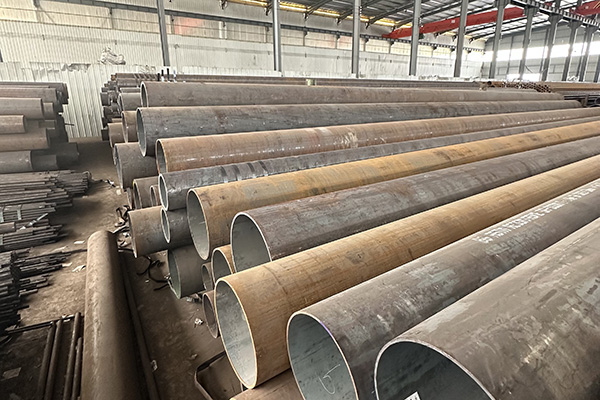
The Backbone of Energy Transport
In today’s global energy landscape, ensuring reliable and safe transport systems is crucial. Among the many components that support oil, natural gas, and refined product movement, the oil and gas alloy pipe has earned a reputation for dependability.
Pipes manufactured to the API 5L X46N specification offer a combination of strength, toughness, and corrosion resistance, making them indispensable in heavy-duty pipelines designed for long-term service.
Why Strength and Durability Matter
Transporting oil and gas over vast distances requires materials that can endure high pressure, thermal fluctuations, and corrosive environments. That is where oil and gas alloy pipe demonstrates its value.
·Yield strength: Close to 317 MPa, giving the pipe resistance to permanent deformation.
·Tensile strength: Roughly 435 MPa, balancing toughness with flexibility.
·Excellent weldability: Ensuring effective construction and field assembly.
·Long service life: Designed to resist cracking, fatigue, and corrosive wear.
These mechanical characteristics ensure safety, reliability, and reduced maintenance throughout the operational cycle.
The Role of API 5L in Alloy Pipe Standards
To ensure global uniformity, the API 5L standard sets the baseline for alloy pipes used in oil and gas industries. Within this framework, X46N has become a preferred grade due to its consistent performance and cost-effectiveness.
Core Advantages of API 5L X46N Alloy Pipe:
1.Controlled chemistry to optimize strength and prevent brittle failure.
2.Microalloying with Nb, V, or Ti, which enhances toughness.
3.Strict PSL2 requirements, including tighter chemical limits and impact testing.
4.International acceptance, enabling use in both domestic and cross-border projects.
These requirements ensure that alloy pipes are not only strong but also reliable under variable operating conditions.
Key Applications of Oil and Gas Alloy Pipe
The scope of oil and gas alloy pipe extends well beyond just energy pipelines.
·Pipeline networks: Transporting crude oil, refined fuels, and natural gas safely.
·Refining and petrochemical sectors: Handling fluids at elevated pressures and temperatures.
·Steam and hot fluid systems: Enduring repetitive heating and cooling cycles.
·Civil infrastructure: Offering reliable strength for critical engineering works.
Its ability to withstand corrosive and high-pressure environments makes it especially suitable for offshore platforms and sour service applications.
Practical Factors for Pipe Selection
Selecting the correct oil and gas alloy pipe involves balancing project requirements with technical specifications. Key elements include:
1.Pressure rating and thermal demands – Ensuring the chosen grade handles system loads.
2.Corrosive environments – Some conditions require enhanced alloy protection.
3.Size and wall thickness – Determined by flow rates and pressure tolerances.
4.Cost-effectiveness over lifecycle – Durable alloys reduce long-term maintenance.
A well-chosen alloy pipe not only increases safety but also minimizes downtime and replacement costs.

Looking Ahead: The Evolution of Alloy Pipes
The need for stronger and more sustainable materials continues to grow. Advances in metallurgy are pushing oil and gas alloy pipe to higher levels of corrosion resistance, impact strength, and weldability.
Meanwhile, the API 5L X46N specification remains an industry benchmark, supporting modern infrastructure while adapting to new energy demands, including transitions toward cleaner fuels and hybrid systems.
Conclusion: Why Oil and Gas Alloy Pipe Stands Out
With its combination of mechanical strength, global standard compliance, and proven durability, the oil and gas alloy pipe is a cornerstone of today’s energy transport systems.
Pipes built to API 5L X46N standards ensure not just performance but also reliability in challenging environments. From offshore operations to long-distance transmission networks, these alloy pipes consistently deliver dependable results.
The message is clear: oil and gas alloy pipe remains the trusted choice for building safe, efficient, and long-lasting energy infrastructure.
References
GB/T 7714:Venegas V, Caleyo F, González J L, et al. EBSD study of hydrogen-induced cracking in API-5 L-X46 pipeline steel[J]. Scripta materialia, 2005, 52(2): 147-152.
MLA:Venegas, V., et al. "EBSD study of hydrogen-induced cracking in API-5 L-X46 pipeline steel." Scripta materialia 52.2 (2005): 147-152.
APA:Venegas, V., Caleyo, F., González, J. L., Baudin, T., Hallen, J. M., & Penelle, R. (2005). EBSD study of hydrogen-induced cracking in API-5 L-X46 pipeline steel. Scripta materialia, 52(2), 147-152.





